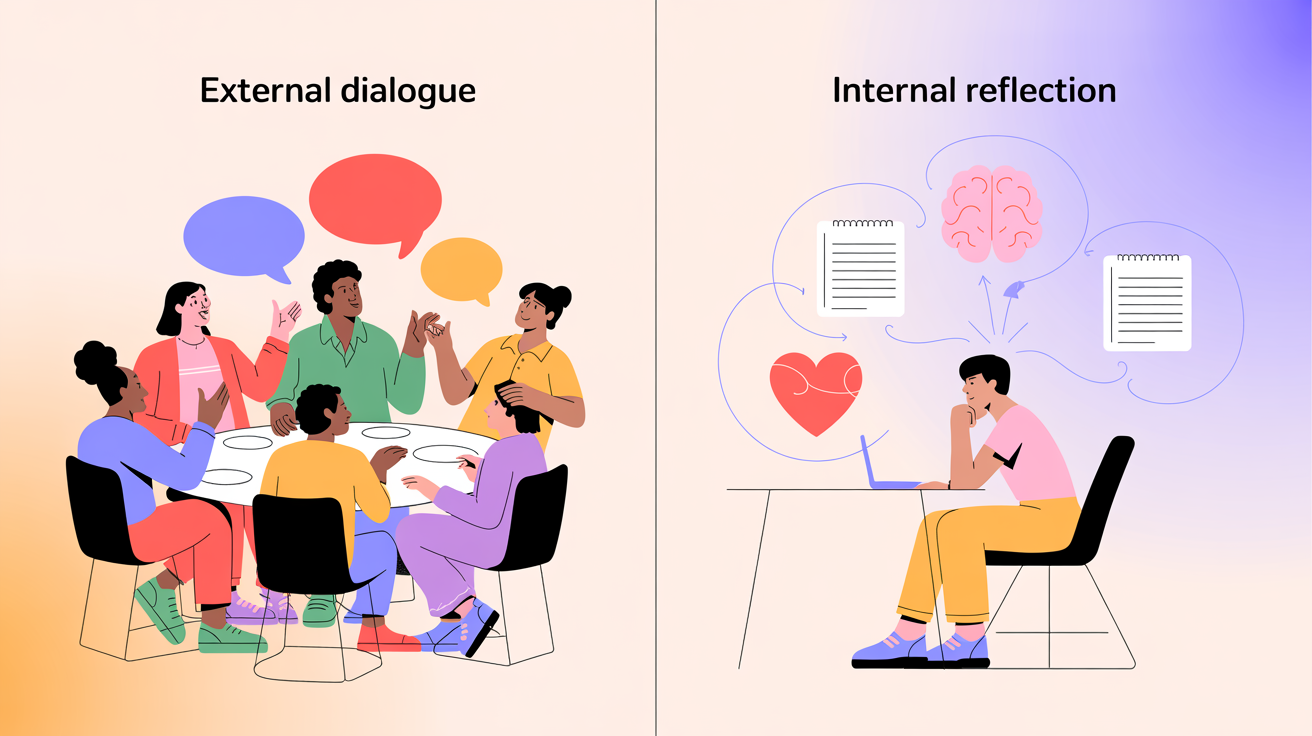Communication is how we connect with others and ourselves. Two main types—interpersonal and intrapersonal communication—may sound similar, but they are quite different in how they work and what they do for us.
Let’s break them down clearly so students, educators, and learners can easily understand and apply them.
Contents
What Do These Terms Mean?
🤝 Interpersonal Communication
This is when you communicate with other people — through speaking, writing, texting, video calls, or even body language. It’s interactive and helps you:
- Build relationships
- Express thoughts and feelings
- Work in teams
- Solve problems with others
It includes verbal (talking or writing) and non-verbal (gestures, tone, facial expressions) forms.
💭 Intrapersonal Communication
This is the communication you have with yourself — your thoughts, self-talk, reflection, planning, and emotional processing. You are both the speaker and the listener. It helps you:
- Understand your feelings
- Make decisions
- Build confidence
- Grow personally
It happens silently in your mind or through writing (like journaling) or even talking aloud to yourself.
Key Differences
| Aspect | Interpersonal | Intrapersonal |
|---|---|---|
| Participants | 2 or more people | Just one person (you!) |
| Type | External (between people) | Internal (within the mind) |
| Visibility | Seen/heard by others | Invisible, private |
| Medium | Verbal, non-verbal, digital tools | Thoughts, feelings, self-talk |
| Purpose | Relationship-building, sharing info | Self-understanding, reflection |
| Feedback | Comes from others | Comes from your own thoughts |
How Do They Work?
Interpersonal Communication Process
- Sender creates a message
- Message is shared (spoken, written, etc.)
- Receiver interprets it
- Feedback is given
- Barriers like noise or miscommunication may interfere
Intrapersonal Communication Process
- Stimulus triggers a thought
- Selective Perception filters it
- Processing happens emotionally and mentally
- Transmission occurs within your body
- Self-Feedback helps you respond internally
Key Features
✨ Interpersonal
- Involves interaction, feedback, and body language
- Context (like culture, mood, relationship) affects it
- Requires listening, empathy, clarity
✨ Intrapersonal
- Continuous and personal
- Helps with emotional control and decision-making
- Involves self-awareness, beliefs, expectations
Interpersonal
- Verbal: Speaking, writing
- Non-verbal: Facial expressions, gestures, tone
- Digital: Emails, texts, video calls
- Listening: Active listening and feedback
Intrapersonal
- Thinking: Daydreaming, reflecting
- Vocal: Talking to yourself aloud
- Written: Journals, diaries, personal notes
Challenges to Watch Out For
| Interpersonal Barriers | Intrapersonal Challenges |
|---|---|
| Noise, distractions, misinterpretation | Negative self-talk, poor self-awareness |
| Cultural/language differences | Emotional overload, self-doubt |
| Lack of confidence or listening | Limiting beliefs, cognitive bias |
Conclusion: Why You Need Both
Both interpersonal and intrapersonal communication are essential for your academic success, career growth, and personal happiness.
- Talk to others → Build strong relationships
- Talk to yourself → Understand who you are
🧩 When you master both, you become more confident, emotionally balanced, and effective in everything you do.
📌 Want More?
Check out:
Explore: https://www.viralandbeyondacademy.com/category/communication-and-media-studies/



